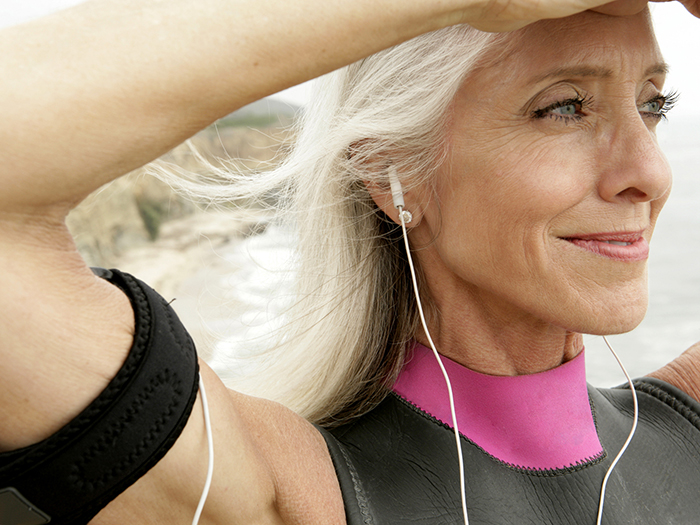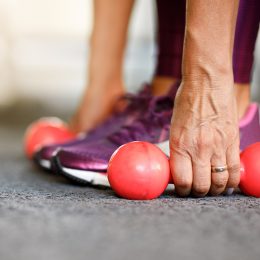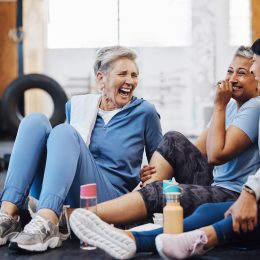3 Types of Exercise Older Adults Should Do Every Week
This trio of activities is the closest thing to a fountain of youth you’ll ever find.

If you want to live a longer, healthier life, then you have to get up and move every day. There’s just one problem: With so many different forms of exercise, how do you choose the best one for you?
It’s a simple question, but the answer’s not so cut and dried.
“The best type of exercise is one you enjoy doing, the exercise that makes you feel better when you’re finished compared to when you started, and the exercise that doesn’t cause any pain,” says fitness expert David Jack.
In other words, there is no “best” type of exercise for an entire group of people. Everyone is different. You have your own pace, passions, and physical limitations. And what may give you energy and help you maintain a healthy weight might feel boring or painful to someone else.
That said, most older adults share a common goal: to maintain the capacity to use your full body. And to do that, there are three key types of workouts that should be incorporated into your routine. Otherwise, Jack says, “if you don’t use it, you do lose it.”
Did you know? SilverSneakers offers classes for all fitness levels — there’s truly something for everyone! Check your eligibility and view the current SilverSneakers LIVE schedule here.
Workout Type #1: Endurance Training
Endurance, or aerobic, activities include anything that gets your breathing and heart rate up. These types of workouts improve the health of your heart, lungs, and circulatory system. They also help delay or prevent many diseases that are common in older adults such as diabetes and heart disease.
Ideally, you’d do some form of moderate-intensity endurance exercise every day, but if that’s not possible, aim to fit in at least 150 minutes of activity per week. You can break it up into however many sessions you need.
When it comes to what you do, the possibilities are seemingly endless: Walking, jogging, hiking, biking, dancing, and swimming are all great options.
“You want to choose an endurance workout that will give you maximum health benefits and do the least amount of damage to your body,” Jack says. “Swimming is a great example. You’ll still work your heart, but the water helps reduce the effects of gravity, so you’re not pushing your bones, ligaments, and joints too hard.”
If you want to try swimming (or get more out of your time in the pool), check out these 10 tips for a better swimming workout.
Not a fan of water workouts? Consider one of these eight low-impact, calorie-burning exercise options.
Workout Type #2: Strength Training
Endurance workouts are important, but if that’s all you do, you run the risk of overworking certain muscles and joints, Jack says.
That doesn’t mean you have to stop jogging if that’s what you love. It simply means you have to balance it with exercises that will allow you to keep going.
“If I want to continue jogging,” Jack says, “then I know I need to keep my glutes strong, my hips durable and capable, and my ankles mobile.”
That’s where strength training comes in. Research shows that as you age, you’ll start to lose a significant amount of muscle mass and strength, making you more susceptible to overuse injuries and falls or fractures.
To maintain the muscle you need, aim to lift weights at the gym or perform bodyweight exercises at home at least two days per week. Learn more about the best exercises you can do in our beginner’s guide to strength training.
If you prefer group fitness classes, SilverSneakers offers a variety of great muscle-strengthening options, including SilverSneakers Classic and SilverSneakers Circuit. Check your eligibility here, or find a location near you here.
Subscribe to our newsletter
It's quick and easy. You could be one of the 13 million people who are eligible.
Already a member? Click to discover our 15,000+ participating locations.
Follow Us
Workout Type #3: Balance and Flexibility Training
Most of the movements you do in your everyday life require some form of balance and coordination, Jack says. So adding things like yoga or tai chi to your routine means you’ll be more solid and confident on your feet.
That’s important, considering one in four Americans ages 65 and older will fall this year, according to the National Council on Aging.
When it comes to yoga, a little bit can go a long way in helping your balance and flexibility. Try adding these five poses to your daily routine as often as possible. Or if you prefer a longer practice, try this do-anywhere sequence specifically designed to improve balance and coordination.
In a SilverSneakers Yoga class, you’ll move through seated and standing poses to improve your balance, flexibility, and range of motion.
Our SilverSneakers EnerChi class is a great introduction to tai chi — and the sessions are appropriate for all fitness levels. You’ll perform modified tai chi movements in a slow, flowing sequence.
SilverSneakers Yoga and EnerChi are offered both in-person at participating SilverSneakers fitness locations (review the gym’s schedule for exact times), or online with SilverSneakers LIVE. See the latest SilverSneakers LIVE schedule and RSVP for classes here.
The bottom line: There’s not one best type of exercise for all older adults. So instead of searching for a magic bullet, focus on creating a weekly routine that combines your favorite endurance, strength, and balance and flexibility exercises.
Take Your Favorite SilverSneakers Classes Online!
SilverSneakers members can access live fitness classes and wellness workshops through SilverSneakers LIVE. See the latest schedule and RSVP for classes here.
Not a member? If you have a Medicare Plan, it may include SilverSneakers—at no additional cost. Check your eligibility instantly here.




